Modulating Optical Characteristics of Nanoimprinted Plasmonic Device by Re-Shaping Process of Polymer Mold
Abstract
:1. Introduction
2. Materials and Methods
2.1. Materials
2.2. Methods
2.2.1. Re-Shaping Process of Polymer Secondly, Mold

2.2.2. Measurement of Optical Characteristics and Responsivities of Plasmonic Devices
2.2.3. Optical Simulation
3. Results
3.1. Re-Shaping Effect on the COP Molds

3.2. Re-Shaping Effect on the Optical Characteristics of Plasmonic Devices Based on Processed COP Molds
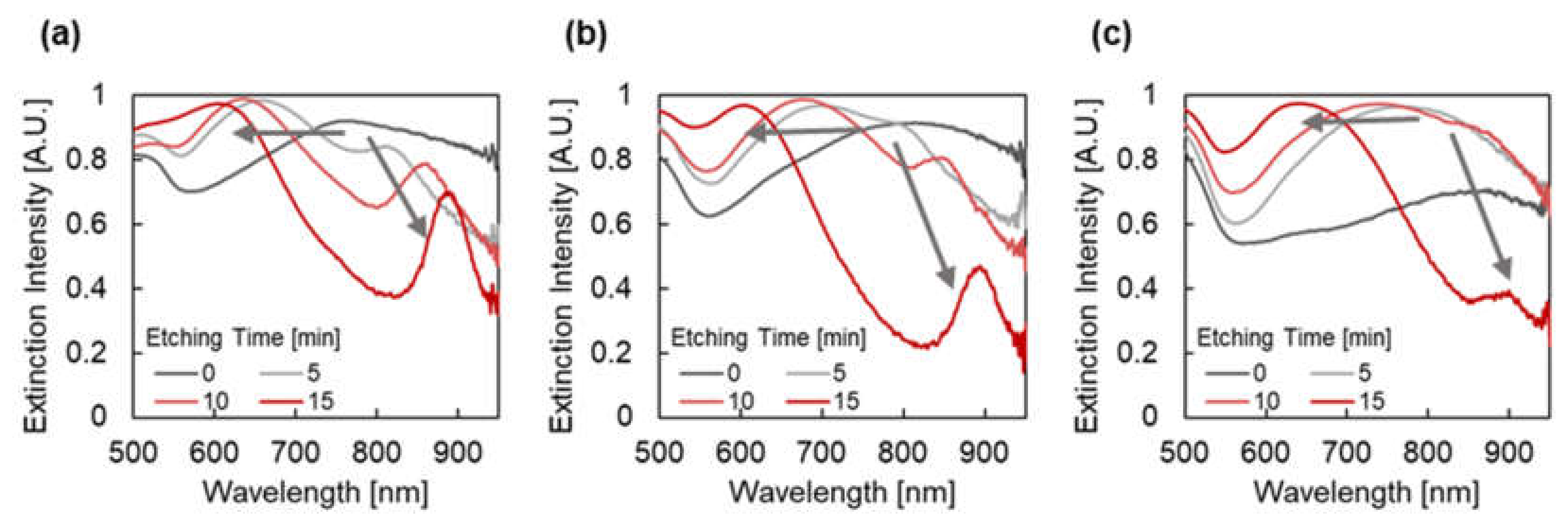
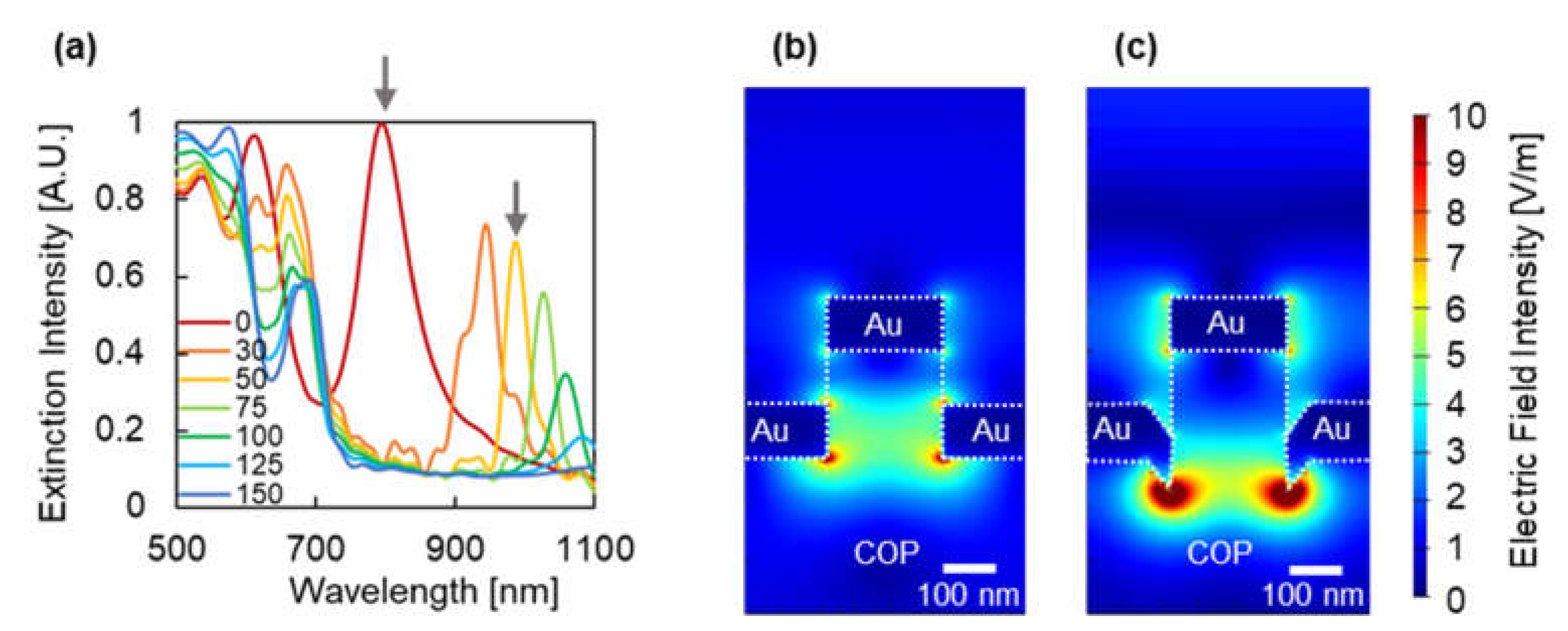
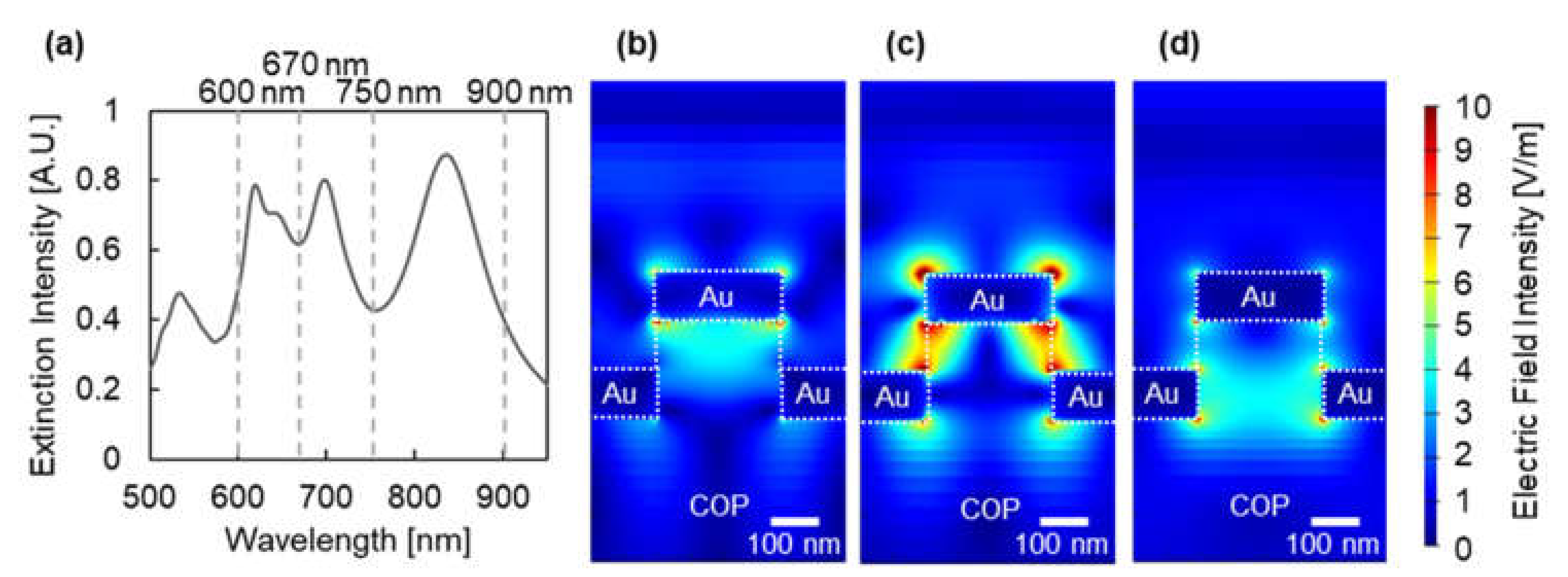
3.3. Re-Shaping Effect on the Responctivities to the Surrounding Refractive Index of Plasmonic Devices Based on Processed COP Molds


4. Discussion
5. Conclusions
Author Contributions
Funding
Institutional Review Board Statement
Informed Consent Statement
Data Availability Statement
Acknowledgments
Conflicts of Interest
References
- Malta, O.L.; Santa-Cruz, P.A.; De Sa, G.F.; Auzel, F. Fluorescence Enhancement Induced by the Presebce of Small Silver Particles in Eu3+ Doped Materials. J. Lumin. 1985, 33, 261–272. [Google Scholar] [CrossRef]
- Glass, A.M.; Wokaun, A.; Heritage, J.P.; Bergman, J.G.; Liao, P.F.; Olson, D.H. Enhanced Two-Photon Fluorescence of Molecules Adsorbed on Silver Particle Films. Phys. Rev. B 1981, 24, 4906–4909. [Google Scholar] [CrossRef]
- Von Raben, K.U.; Chang, R.K.; Laube, B.L. Surface Enhanced Raman Scattering of Au(CN)2− Ions Adsorbed on Gold Colloids. Chem. Phys. Lett. 1981, 79, 465–469. [Google Scholar] [CrossRef]
- García De Arquer, F.P.; Mihi, A.; Kufer, D.; Konstantatos, G. Photoelectric Energy Conversion of Plasmon-Generated Hot Carriers in Metal-Insulator-Semiconductor Structures. ACS Nano 2013, 7, 3581–3588. [Google Scholar] [CrossRef] [PubMed]
- Lin, L.; Gao, G.Q.; Zhu, Q.; Xu, A.W. Plasmon Enhanced Photocurrent in Strongly Coupled Ag@perylene Core-Shell Nanowires. J. Mater. Chem. A 2015, 3, 12845–12851. [Google Scholar] [CrossRef]
- Zhou, L.; Zhang, H.; Luan, Y.; Cheng, S.; Fan, L.J. Amplified Detection of Iron Ion Based on Plasmon Enhanced Fluorescence and Subsequently Fluorescence Quenching. Nano Micro Lett. 2014, 6, 327–334. [Google Scholar] [CrossRef] [PubMed] [Green Version]
- Mei, Z.; Tang, L. Surface-Plasmon-Coupled Fluorescence Enhancement Based on Ordered Gold Nanorod Array Biochip for Ultrasensitive DNA Analysis. Anal. Chem. 2017, 89, 633–639. [Google Scholar] [CrossRef]
- Takemura, K.; Adegoke, O.; Takahashi, N.; Kato, T.; Li, T.C.; Kitamoto, N.; Tanaka, T.; Suzuki, T.; Park, E.Y. Versatility of a Localized Surface Plasmon Resonance-Based Gold Nanoparticle-Alloyed Quantum Dot Nanobiosensor for Immunofluorescence Detection of Viruses. Biosens. Bioelectron. 2017, 89, 998–1005. [Google Scholar] [CrossRef]
- Jiang, L.; Hang, X.; Zhang, P.; Zhang, J.; Wang, Y.; Wang, W.; Ren, L. A Highly Sensitive Fluorescence-Enhanced Aptasensor Based on PolyA n -Aptamer Nanostructure. Microchem. J. 2019, 148, 285–290. [Google Scholar] [CrossRef]
- Song, C.; Wang, Z.; Zhang, R.; Yang, J.; Tan, X.; Cui, Y. Highly Sensitive Immunoassay Based on Raman Reporter-Labeled Immuno-Au Aggregates and SERS-Active Immune Substrate. Biosens. Bioelectron. 2009, 25, 826–831. [Google Scholar] [CrossRef]
- Lemma, T.; Saliniemi, A.; Hynninen, V.; Hytönen, V.P.; Toppari, J.J. SERS Detection of Cell Surface and Intracellular Components of Microorganisms Using Nano-Aggregated Ag Substrate. Vib. Spectrosc. 2016, 83, 36–45. [Google Scholar] [CrossRef]
- Peyskens, F.; Dhakal, A.; van Dorpe, P.; le Thomas, N.; Baets, R. Surface Enhanced Raman Spectroscopy Using a Single Mode Nanophotonic-Plasmonic Platform. ACS Photonics 2016, 3, 102–108. [Google Scholar] [CrossRef] [Green Version]
- Macdonald, D.; Smith, E.; Faulds, K.; Graham, D. DNA Detection by SERS: Hybridisation Parameters and the Potential for Asymmetric PCR. Analyst 2020, 145, 1871–1877. [Google Scholar] [CrossRef]
- Endo, T.; Yamamura, S.; Kerman, K.; Tamiya, E. Label-Free Cell-Based Assay Using Localized Surface Plasmon Resonance Biosensor. Anal. Chim. Acta 2008, 614, 182–189. [Google Scholar] [CrossRef] [PubMed]
- Sun, W.; Yuan, S.; Huang, H.; Liu, N.; Tan, Y. A Label-Free Biosensor Based on Localized Surface Plasmon Resonance for Diagnosis of Tuberculosis. J. Microbiol. Methods 2017, 142, 41–45. [Google Scholar] [CrossRef] [PubMed]
- Cetin, A.E.; Topkaya, S.N.; Yalcin-Ozuysal, O.; Khademhosseini, A. Refractive Index Sensing for Measuring Single Cell Growth. ACS Nano 2021, 15, 10710–10721. [Google Scholar] [CrossRef] [PubMed]
- Willets, K.A.; van Duyne, R.P. Localized Surface Plasmon Resonance Spectroscopy and Sensing. Ann. Rev. Phys. Chem. 2007, 58, 267–297. [Google Scholar] [CrossRef] [PubMed] [Green Version]
- Fong, K.E.; Yung, L.Y.L. Localized Surface Plasmon Resonance: A Unique Property of Plasmonic Nanoparticles for Nucleic Acid Detection. Nanoscale 2013, 5, 12043–12071. [Google Scholar] [CrossRef] [PubMed]
- Petryayeva, E.; Krull, U.J. Localized Surface Plasmon Resonance: Nanostructures, Bioassays and Biosensing-A Review. Anal. Chim. Acta 2011, 706, 8–24. [Google Scholar] [CrossRef] [PubMed]
- Jain, P.K.; Eustis, S.; El-Sayed, M.A. Plasmon Coupling in Nanorod Assemblies: Optical Absorption, Discrete Dipole Approximation Simulation, and Exciton-Coupling Model. J. Phys. Chem. B 2006, 110, 18243–18253. [Google Scholar] [CrossRef]
- Chen, H.; Kou, X.; Yang, Z.; Ni, W.; Wang, J. Shape- and Size-Dependent Refractive Index Sensitivity of Gold Nanoparticles. Langmuir 2008, 24, 5233–5237. [Google Scholar] [CrossRef] [PubMed]
- Kooij, E.S.; Ahmed, W.; Zandvliet, H.J.W.; Poelsema, B. Localized Plasmons in Noble Metal Nanospheroids. J. Phys. Chem. C 2011, 115, 10321–10332. [Google Scholar] [CrossRef]
- Métraux, G.S.; Mirkin, C.A. Rapid Thermal Synthesis of Silver Nanoprisms with Chemically Tailorable Thickness. Adv. Mater. 2005, 17, 412–415. [Google Scholar] [CrossRef]
- Rycenga, M.; Cobley, C.M.; Zeng, J.; Li, W.; Moran, C.H.; Zhang, Q.; Qin, D.; Xia, Y. Controlling the Synthesis and Assembly of Silver Nanostructures for Plasmonic Applications. Chem. Rev. 2011, 111, 3669–3712. [Google Scholar] [CrossRef] [PubMed] [Green Version]
- Zhang, X.; Yonzon, C.R.; van Duyne, R.P. Nanosphere Lithography Fabricated Plasmonic Materials and Their Applications. J. Mater. Res. 2006, 21, 1083–1092. [Google Scholar] [CrossRef] [Green Version]
- Roxworthy, B.J.; Ko, K.D.; Kumar, A.; Fung, K.H.; Chow, E.K.C.; Liu, G.L.; Fang, N.X.; Toussaint, K.C. Application of Plasmonic Bowtie Nanoantenna Arrays for Optical Trapping, Stacking, and Sorting. Nano Lett. 2012, 12, 796–801. [Google Scholar] [CrossRef] [PubMed]
- Couture, M.; Ray, K.K.; Poirier-Richard, H.P.; Crofton, A.; Masson, J.F. 96-Well Plasmonic Sensing with Nanohole Arrays. ACS Sens. 2016, 1, 287–294. [Google Scholar] [CrossRef]
- Zhang, C.; Gao, T.; Sheets, D.; Hancock, J.N.; Tresback, J.; Willis, B. Tunable and Scalable Fabrication of Plasmonic Dimer Arrays with Sub-10 nm Nanogaps by Area-Selective Atomic Layer Deposition. J. Vac. Sci. Technol. B 2021, 39, 053203. [Google Scholar] [CrossRef]
- Lee, H.S.; Hwang, G.W.; Seong, T.Y.; Park, J.; Kim, J.W.; Kim, W.M.; Kim, I.; Lee, K.S. Design of Mid-Infrared Filter Array Based on Plasmonic Metal Nanodiscs Array and Its Application to on-Chip Spectrometer. Sci. Rep. 2021, 11, 12218. [Google Scholar] [CrossRef]
- Hicks, E.M.; Zou, S.; Schatz, G.C.; Spears, K.G.; van Duyne, R.P.; Gunnarsson, L.; Rindzevicius, T.; Kasemo, B.; Käll, M. Controlling Plasmon Line Shapes through Diffractive Coupling in Linear Arrays of Cylindrical Nanoparticles Fabricated by Electron Beam Lithography. Nano Lett. 2005, 5, 1065–1070. [Google Scholar] [CrossRef] [PubMed]
- Yue, W.; Gong, T.; Long, X.; Kravets, V.; Gao, P.; Pu, M.; Wang, C. Sensitive and Reproducible Surface-Enhanced Raman Spectroscopy (SERS) with Arrays of Dimer-Nanopillars. Sens. Actuators B Chem. 2020, 322, 128563. [Google Scholar] [CrossRef]
- Huang, J.; Fan, D.; Ekinci, Y.; Padeste, C. Fabrication of Ultrahigh Resolution Metal Nanowires and Nanodots through EUV Interference Lithography. Microelectron. Eng. 2015, 141, 32–36. [Google Scholar] [CrossRef]
- Mojarad, N.; Kazazis, D.; Ekinci, Y. Fabrication of High Aspect Ratio and Tilted Nanostructures Using Extreme Ultraviolet and Soft X-Ray Interference Lithography. J. Vac. Sci. Technol. B 2021, 39, 042601. [Google Scholar] [CrossRef]
- Einsle, J.F.; Bouillard, J.S.; Dickson, W.; Zayats, A.V. Hybrid FIB Milling Strategy for the Fabrication of Plasmonic Nanostructures on Semiconductor Substrates. Nanoscale Res. Lett. 2011, 6, 1–5. [Google Scholar] [CrossRef] [PubMed] [Green Version]
- Mori, T.; Mori, T.; Tanaka, Y.; Suzaki, Y.; Yamaguchi, K. Fabrication of Single-Crystalline Plasmonic Nanostructures on Transparent and Flexible Amorphous Substrates. Sci. Rep. 2017, 7, 42859. [Google Scholar] [CrossRef] [Green Version]
- Guo, L.J. Nanoimprint Lithography: Methods and Material Requirements. Adv. Mater. 2007, 19, 495–513. [Google Scholar] [CrossRef] [Green Version]
- Ahn, S.H.; Guo, L.J. High-Speed Roll-to-Roll Nanoimprint Lithography on Flexible Plastic Substrates. Adv. Mater. 2008, 20, 2044–2049. [Google Scholar] [CrossRef] [Green Version]
- Lucas, B.D.; Kim, J.S.; Chin, C.; Guo, L.J. Nanoimprint Lithography Based Approach for the Fabrication of Large-Area, Uniformly Oriented Plasmonic Arrays. Adv. Mater. 2008, 20, 1129–1134. [Google Scholar] [CrossRef] [Green Version]
- Fu, Y.Q.; Colli, A.; Fasoli, A.; Luo, J.K.; Flewitt, A.J.; Ferrari, A.C.; Milne, W.I. Deep Reactive Ion Etching as a Tool for Nanostructure Fabrication. J. Vac. Sci. Technol. B 2009, 27, 1520. [Google Scholar] [CrossRef] [Green Version]
- Saffih, F.; Con, C.; Alshammari, A.; Yavuz, M.; Cui, B. Fabrication of Silicon Nanostructures with Large Taper Angle by Reactive Ion Etching. J. Vac. Sci. Technol. B 2014, 32, 06FI04. [Google Scholar] [CrossRef] [Green Version]
- Chen, P.; Tran, N.T.; Wen, X.; Xiong, Q.; Liedberg, B. Inflection Point of the Localized Surface Plasmon Resonance Peak: A General Method to Improve the Sensitivity. ACS Sens. 2017, 2, 235–242. [Google Scholar] [CrossRef] [PubMed]
- Jeon, H.B.; Tsalu, P.V.; Ha, J.W. Shape Effect on the Refractive Index Sensitivity at Localized Surface Plasmon Resonance Inflection Points of Single Gold Nanocubes with Vertices. Sci. Rep. 2019, 9, 13635. [Google Scholar] [CrossRef] [Green Version]
- Ryu, K.R.; Kim, G.W.; Ha, J.W. Localized Surface Plasmon Resonance Inflection Points for Improved Detection of Chemisorption of 1-Alkanethiols under Total Internal Reflection Scattering Microscopy. Sci. Rep. 2021, 11, 12902. [Google Scholar] [CrossRef] [PubMed]
- Nicolas, R.; Lévêque, G.; Marae-Djouda, J.; Montay, G.; Madi, Y.; Plain, J.; Herro, Z.; Kazan, M.; Adam, P.M.; Maurer, T. Plasmonic Mode Interferences and Fano Resonances in Metal-Insulator- Metal Nanostructured Interface. Sci. Rep. 2015, 5, 14419. [Google Scholar] [CrossRef] [PubMed] [Green Version]
- Kluczyk, K.; Jacak, W.A. Size Effect in Plasmon Resonance of Metallic Nanoparticles: RPA versus COMSOL. Acta Phys. Pol. A 2016, 129, A83–A86. [Google Scholar] [CrossRef]
- Chang, Y.C.; Wang, S.M.; Chung, H.C.; Tseng, C.B.; Chang, S.H. Observation of Absorption-Dominated Bonding Dark Plasmon Mode from Metal-Insulator-Metal Nanodisk Arrays Fabricated by Nanospherical-Lens Lithography. ACS Nano 2012, 6, 3390–3396. [Google Scholar] [CrossRef] [PubMed]
- Qin, C.; Guo, Y.; Seo, J.; Shuai, Y.; Lee, J.; Lee, B.J. Absorption Characteristics of a Metal-Insulator-Metal Nanodisk for Solar Thermal Applications. Opt. Express 2020, 28, 15731. [Google Scholar] [CrossRef]
- Cetin, A.E.; Etezadi, D.; Galarreta, B.C.; Busson, M.P.; Eksioglu, Y.; Altug, H. Plasmonic Nanohole Arrays on a Robust Hybrid Substrate for Highly Sensitive Label-Free Biosensing. ACS Photonics 2015, 2, 1167–1174. [Google Scholar] [CrossRef]
- Du, C.; Wang, B.; Sun, F.; Huang, M.; He, C.; Liu, Y.; Zhang, X.; Shi, D. Refractive Index Sensitivities of Plane Ag Nanosphere Cluster Sensors. Sens. Actuators B 2015, 215, 142–145. [Google Scholar] [CrossRef]
- Du, C.L.; Peng, S.; Yang, W.C.; Shi, D.N. Plasmonic Coupling Effects on the Refractive Index Sensitivities of Plane Au-Nanosphere-Cluster Sensors. Plasmonics 2018, 13, 1729–1734. [Google Scholar] [CrossRef]
- Robbie, K. Advanced Techniques for Glancing Angle Deposition. J. Vac. Sci. Technol. B 1998, 16, 1115. [Google Scholar] [CrossRef]
- Eschimese, D.; Vaurette, F.; Troadec, D.; Leveque, G.; Melin, T.; Arscott, S. Size and Shape Control of a Variety of Metallic Nanostructures Using Tilted, Rotating Evaporation and Lithographic Lift-off Techniques. Sci. Rep. 2019, 9, 7682. [Google Scholar] [CrossRef] [PubMed]
- Im, H.; Sutherland, J.N.; Maynard, J.A.; Oh, S.H. Nanohole-Based Surface Plasmon Resonance Instruments with Improved Spectral Resolution Quantify a Broad Range of Antibody-Ligand Binding Kinetics. Anal. Chem. 2012, 84, 1941–1947. [Google Scholar] [CrossRef] [PubMed] [Green Version]
- Lee, S.W.; Lee, K.S.; Ahn, J.; Lee, J.J.; Kim, M.G.; Shin, Y.B. Highly Sensitive Biosensing Using Arrays of Plasmonic Au Nanodisks Realized by Nanoimprint Lithography. ACS Nano 2011, 5, 897–904. [Google Scholar] [CrossRef]
- Liang, Y.; Zhang, H.; Zhu, W.; Agrawal, A.; Lezec, H.; Li, L.; Peng, W.; Zou, Y.; Lu, Y.; Xu, T. Subradiant Dipolar Interactions in Plasmonic Nanoring Resonator Array for Integrated Label-Free Biosensing. ACS Sens. 2017, 2, 1796–1804. [Google Scholar] [CrossRef]
- Mohapatra, S.; Moirangthem, R.S. Fabrication of Flexible and Economical Plasmonic Biosensor Using Gold Nanograting Imprinted on Hot-Melt Adhesive Film for Label-Free Sensing of Immunoglobulin Proteins. Sens. Actuators B 2019, 301, 127070. [Google Scholar] [CrossRef]
- Verellen, N.; van Dorpe, P.; Huang, C.; Lodewijks, K.; Vandenbosch, G.A.E.; Lagae, L.; Moshchalkov, V.V. Plasmon Line Shaping Using Nanocrosses for High Sensitivity Localized Surface Plasmon Resonance Sensing. Nano Lett. 2011, 11, 391–397. [Google Scholar] [CrossRef] [PubMed]
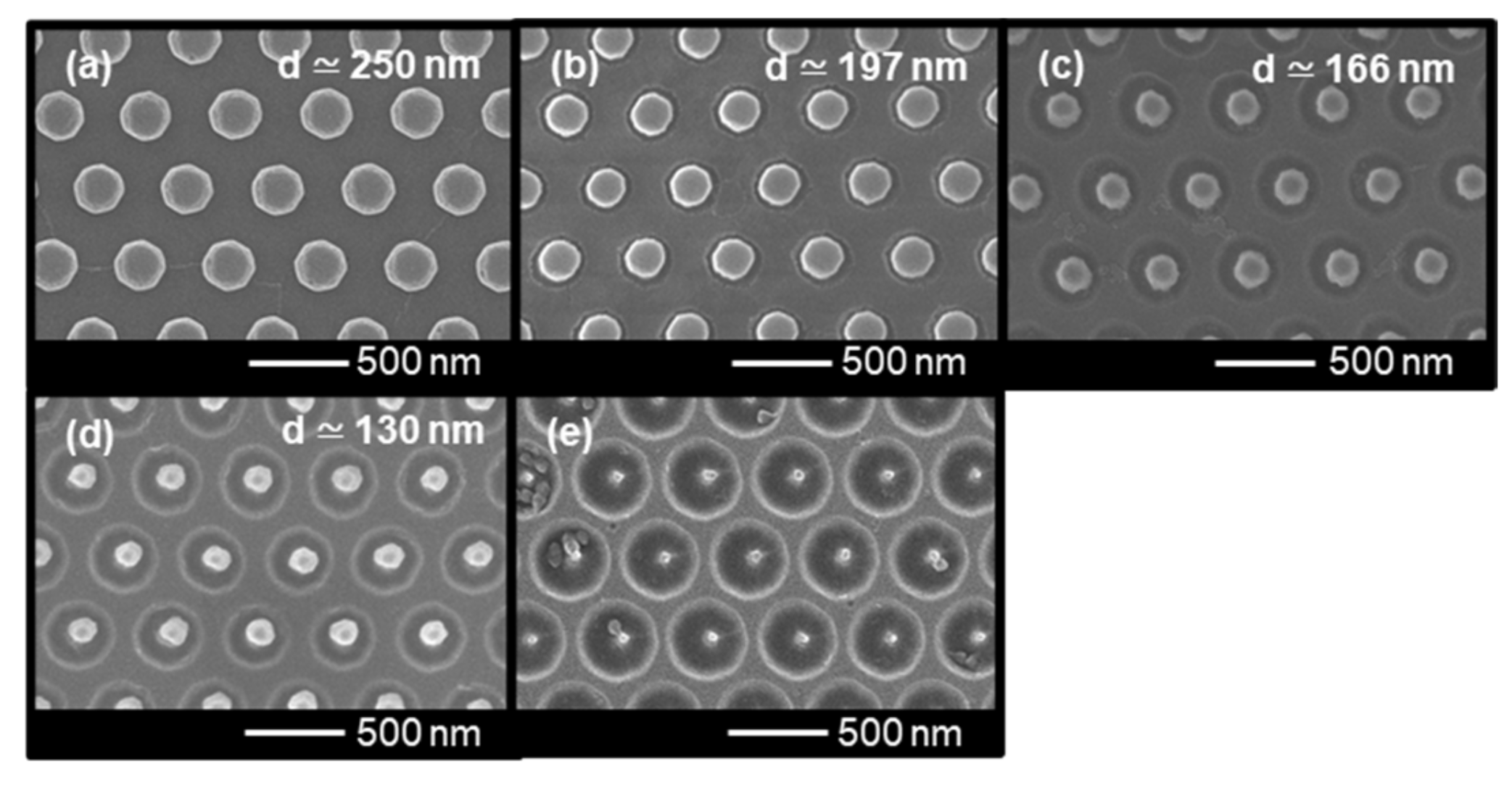
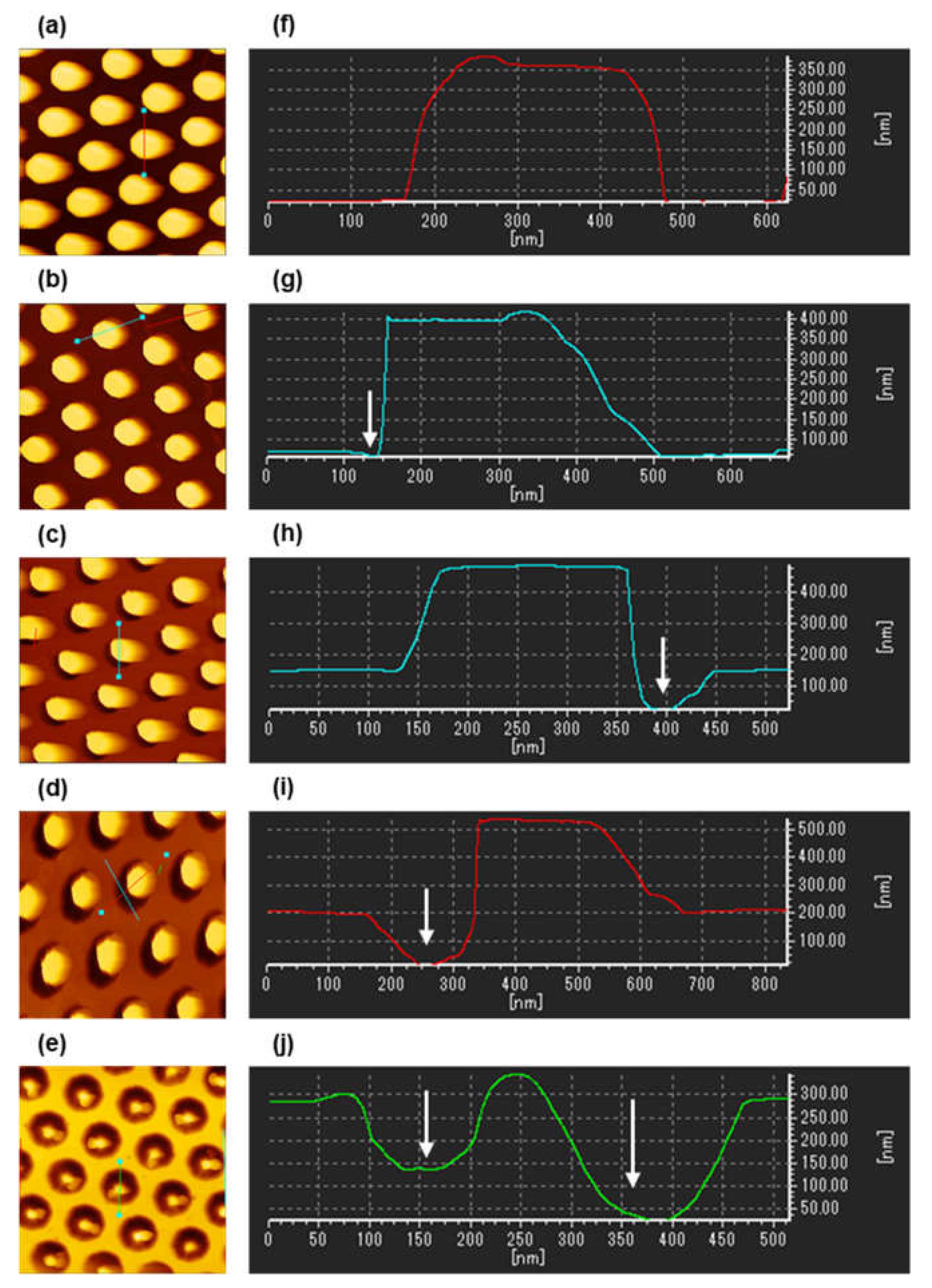

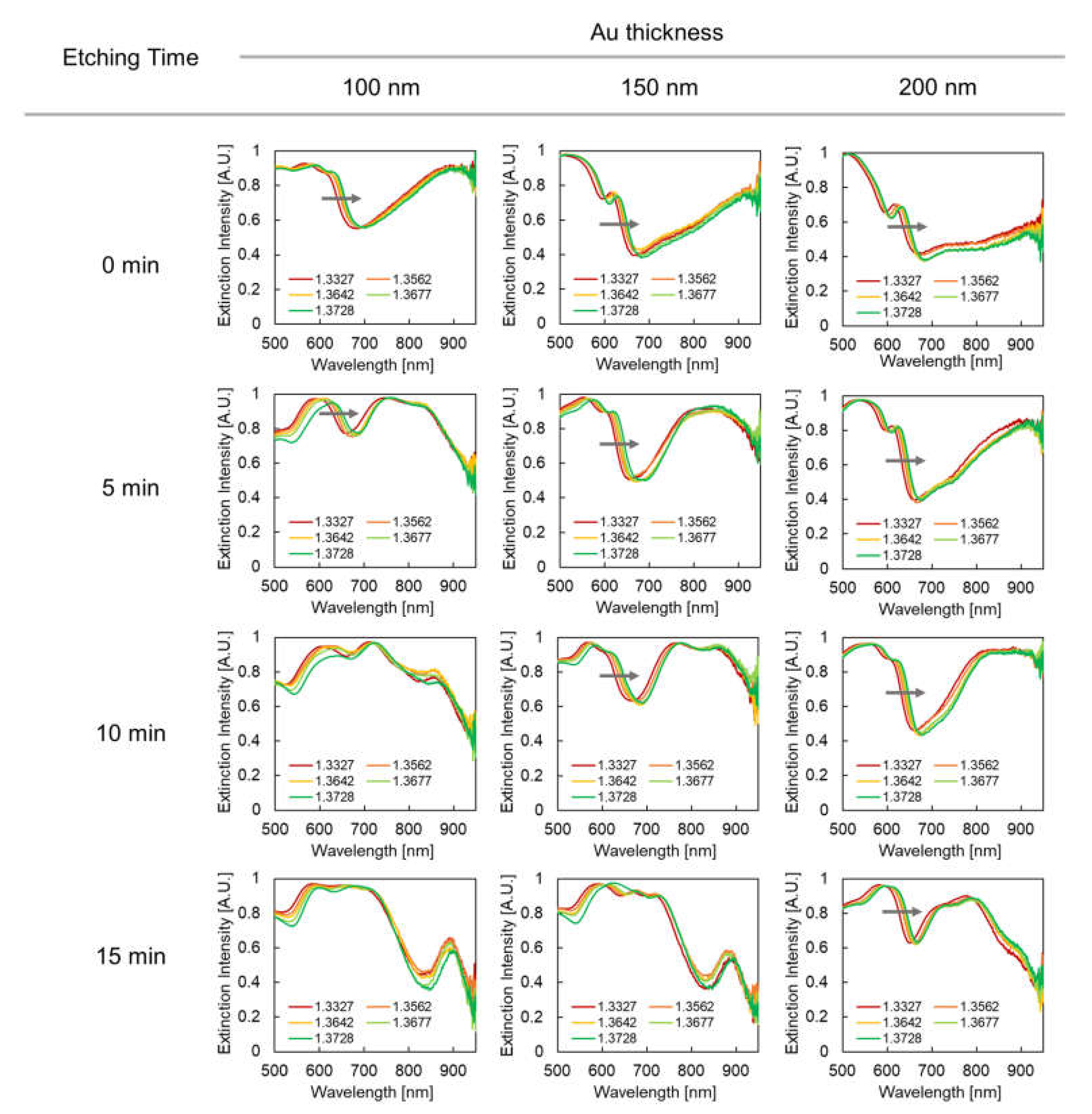


| Ref. | Structure | Wavelength (nm) | Responsivity (nm/RIU) |
|---|---|---|---|
| This work | Pillar-hole structure | 625 | 906 |
| [21] | colloidal nanorod | 846 | 288 |
| [53] | nanohole | 710 | 481 |
| [54] | nanodisk array | 830 | 327 |
| [55] | nanoring array | 750 | 513 |
| [56] | nanograting | 982 | 886 |
| [57] | nanocross and bar | 1800 | 1000 |
Publisher’s Note: MDPI stays neutral with regard to jurisdictional claims in published maps and institutional affiliations. |
© 2021 by the authors. Licensee MDPI, Basel, Switzerland. This article is an open access article distributed under the terms and conditions of the Creative Commons Attribution (CC BY) license (https://creativecommons.org/licenses/by/4.0/).
Share and Cite
Yamada, H.; Sueyoshi, K.; Hisamoto, H.; Endo, T. Modulating Optical Characteristics of Nanoimprinted Plasmonic Device by Re-Shaping Process of Polymer Mold. Micromachines 2021, 12, 1323. https://doi.org/10.3390/mi12111323
Yamada H, Sueyoshi K, Hisamoto H, Endo T. Modulating Optical Characteristics of Nanoimprinted Plasmonic Device by Re-Shaping Process of Polymer Mold. Micromachines. 2021; 12(11):1323. https://doi.org/10.3390/mi12111323
Chicago/Turabian StyleYamada, Hirotaka, Kenji Sueyoshi, Hideaki Hisamoto, and Tatsuro Endo. 2021. "Modulating Optical Characteristics of Nanoimprinted Plasmonic Device by Re-Shaping Process of Polymer Mold" Micromachines 12, no. 11: 1323. https://doi.org/10.3390/mi12111323
APA StyleYamada, H., Sueyoshi, K., Hisamoto, H., & Endo, T. (2021). Modulating Optical Characteristics of Nanoimprinted Plasmonic Device by Re-Shaping Process of Polymer Mold. Micromachines, 12(11), 1323. https://doi.org/10.3390/mi12111323






